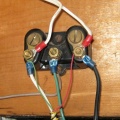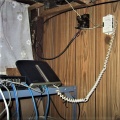Difference between revisions of "Home Wiring"
m (→Line filter at the demarcation point: added "a") |
m |
||
| (9 intermediate revisions by 2 users not shown) | |||
| Line 1: | Line 1: | ||
<div class="ncfrightbox"> {{Template:Troubleshooting DSL Links}} </div> | |||
This page outlines some tips for wiring your location for DSL. | This page outlines some tips for wiring your location for DSL. | ||
=Line filter at the demarcation point= | |||
In most homes there is a box or junction just inside where the Bell line enters your location. This is called the ''demarcation point''. | In most homes there is a box or junction just inside where the Bell line enters your location. This is called the ''demarcation point''. All the wiring inside the demarcation point, along with any associated problems, are owned by the building owner. All wiring from the demarcation point going to the outside world are owned by Bell and are their responsibility to repair. Usually there is one line going into the demarcation point from Bell's outside lines and then one wire coming out of the demarcation point which connects to all the phone jacks in your house. | ||
<gallery> | <gallery> | ||
| Line 12: | Line 12: | ||
</gallery> | </gallery> | ||
Instead of putting a DSL line filter on each device attached to your phone line at your location (except your DSL modem, of course), you could put one line filter at your demarcation point for your whole house. That would involve installing a jack at the demarcation point, then a splitter to create two parallel jacks. On one jack install a line filter and connect the house wiring to that line filter. Then connect the line to the DSL modem to the other jack. | |||
<!-- (Note: It would be good to have a diagram here showing the wiring) --> | <!-- (Note: It would be good to have a diagram here showing the wiring) --> | ||
| Line 24: | Line 24: | ||
But there are shortcomings to this method too: | But there are shortcomings to this method too: | ||
* The modem probably ends up in the basement ceiling and thus is not easily accessible. This means that you won't be easily able to see the lights when working on your computer. From a useability viewpoint, it is best to have your DSL modem within sight of your usual location when at the computer, so that you can see what your modem is doing, but it is certainly not essential. | * The modem probably ends up in the basement ceiling and thus is not easily accessible. This means that you won't be easily able to see the lights when working on your computer. From a useability viewpoint, it is best to have your DSL modem within sight of your usual location when at the computer, so that you can see what your modem is doing, but it is certainly not essential. | ||
* It's a bit of a chore to change the wiring at the demarcation point and you will need some hardware, such as a junction box. | * It's a bit of a chore to change the wiring at the demarcation point and you will need some hardware, such as a junction box. | ||
There are junction boxes made for this, with built-in DSL line filters. These may also possibly have higher quality filters too. | There are junction boxes made for this, with built-in DSL line filters. These may also possibly have higher quality filters too. | ||
= Ethernet cables through heating ducts = | |||
Ethernet cables can be routed through heating ducts. One way to feed a cable through a long, curving duct is to tie a paper tissue to a thread and then blow the tissue through the duct using the exhaust from a vacuum cleaner. The thread can then be used to pull a string through, which then can be used to pull an ethernet cable through. | Ethernet cables can be routed through heating ducts. One way to feed a cable through a long, curving duct is to tie a paper tissue to a thread and then blow the tissue through the duct using the exhaust from a vacuum cleaner. The thread can then be used to pull a string through, which then can be used to pull an ethernet cable through. | ||
Of course wireless is way to avoid all the hassles of cabling | Of course [[About wireless|wireless]] is one way to avoid all the hassles of cabling, but it provides a slower connection than ethernet, may suffer from interference and must be operated in a secure mode to avoid privacy and security issues. | ||
[[Category:DSL]] | [[Category:DSL]] | ||
[[Category:Troubleshooting]] | |||
Latest revision as of 15:40, 28 July 2018
This page outlines some tips for wiring your location for DSL.
Line filter at the demarcation point
In most homes there is a box or junction just inside where the Bell line enters your location. This is called the demarcation point. All the wiring inside the demarcation point, along with any associated problems, are owned by the building owner. All wiring from the demarcation point going to the outside world are owned by Bell and are their responsibility to repair. Usually there is one line going into the demarcation point from Bell's outside lines and then one wire coming out of the demarcation point which connects to all the phone jacks in your house.
Instead of putting a DSL line filter on each device attached to your phone line at your location (except your DSL modem, of course), you could put one line filter at your demarcation point for your whole house. That would involve installing a jack at the demarcation point, then a splitter to create two parallel jacks. On one jack install a line filter and connect the house wiring to that line filter. Then connect the line to the DSL modem to the other jack.
This is optimal for many reasons:
- Your DSL modem is as close as possible to the demarcation point and thus is likely to receive as clean a signal as possible.
- You only need one line filter.
- No need to have line filters hanging on all lines to your devices thoroughout the house.
- You can easily disconnect the house wiring if you need to isolate the DSL modem for troubleshooting.
- Having the modem hidden out of the way in the basement can be nice. The basement is likely a good location for ethernet cables to terminate and also as a wireless access point.
But there are shortcomings to this method too:
- The modem probably ends up in the basement ceiling and thus is not easily accessible. This means that you won't be easily able to see the lights when working on your computer. From a useability viewpoint, it is best to have your DSL modem within sight of your usual location when at the computer, so that you can see what your modem is doing, but it is certainly not essential.
- It's a bit of a chore to change the wiring at the demarcation point and you will need some hardware, such as a junction box.
There are junction boxes made for this, with built-in DSL line filters. These may also possibly have higher quality filters too.
Ethernet cables through heating ducts
Ethernet cables can be routed through heating ducts. One way to feed a cable through a long, curving duct is to tie a paper tissue to a thread and then blow the tissue through the duct using the exhaust from a vacuum cleaner. The thread can then be used to pull a string through, which then can be used to pull an ethernet cable through.
Of course wireless is one way to avoid all the hassles of cabling, but it provides a slower connection than ethernet, may suffer from interference and must be operated in a secure mode to avoid privacy and security issues.



